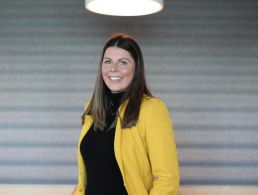BT’s Nicola Millard and CWIT’s Liana Tomescu talk about what impact creativity and communication can have on inspiring the next generation of STEM success stories.
Most people would probably acknowledge that science and technology would not go very far without communication and creativity.
Indeed, some have gone so far as to add an extra letter into a commonly used acronym, changing it from STEM (science, technology, engineering and maths) to STEAM (science, technology, engineering, arts and maths). The arts have been influencing the STEM industry in a variety of ways over the years, from the painter who created camouflage to the influence of origami on self-assembling robots.
But it could be argued that bringing the arts into science and technology is also about applying creative thinking to STEM projects, and tapping into the humanities to find new ways to get people interested and on board with science and tech.
This is something that Nicola Millard and Liana Tomescu have done in their careers, bringing together technology and creative communication – from book clubs and pyschology-inspired storytelling to “speed dating” for tech ideas.
Tomescu and Millard both appeared at a virtual event run by Connecting Women in Technology (CWIT) as part of the 2022 BT Young Scientist and Technology Exhibition last month. Millard is a principal innovation partner with BT in the UK, while Tomescu works in cybersecurity for Microsoft in Ireland. They joined a panel of other tech professionals to discuss the future of technology, and SiliconRepublic.com had a chat with both women after the event.
Tomescu might have only graduated in 2016, but that hasn’t stopped her from becoming involved in advocacy work alongside her day job in Microsoft Ireland’s cybersecurity team. She now works with CWIT as its early careers pillar lead.
She joined the organisation initially as a volunteer before getting “really, really involved in it”. Then, she said to herself, “Why don’t I lead?” Her bosses at Microsoft were very supportive as the company was one of CWIT’s founders when it was established more than a decade ago.
The Irish tech network offers several different outreach programmes for encouraging young women and girls (and underrepresented people in general, Tomescu clarified) into the STEM sector. Tomescu’s Tech Starter ‘pillar’ comes in at the third-level stage, organising careers workshops, networking events, panel discussions and giving young people the opportunities to ask questions to women who are actually working in the STEM industry.
Her work is focused on finding new and creative ways to inspire the next generation of tech stars and giving them the chance to see women role models in action at events, both virtual and in-person around the country. Tomescu said it’s vital to show girls and women “what’s possible for them” and she personally has also benefitted from seeing women represented in the STEM sector.
Tomescu runs a book club as part of her work with CWIT. It offers participants a chance to read and discuss books, mostly with a “feminist focus”, in an informal way. One of the most memorable sessions for Tomescu was when they read and discussed Caroline Criado Perez’s Invisible Women: Data Bias in a World Designed for Men.
The events function as a sort of an informal fireside chat, and she has plans to expand the book club to include podcasts and TV shows to get more people to engage with STEM topics in a creative way.
BT’s Millard is also someone who knows just how important communication is when it comes to introducing people to technology. The former futurologist at BT has been working with the company since the early 1990s.
She started out in artificial intelligence when the company was “in the first flush” of AI. Nowadays, she specialises in explaining new tech innovations to BT’s industry partners as a principal innovation partner.
It’s a challenging job that requires a lot hand-holding as businesses overcome their anxieties about AI, machine learning and other emerging areas of tech. Indeed, Millard describes her job as being kind of like “speed dating” for ideas.
Her sense of humour and skill at reducing intimidating tech terms down to easily understandable concepts really shines through as she talks over Zoom from her base in Ipswich in the UK. She uses her background in psychology – she described herself as being “half psychologist, half technologist” – to help her explain to people how they can make tech work for them, or not, as the case may be.
“I’ve always claimed that people are the most disruptive part of innovation, because there are some incredible technologies out there that unless they’re adopted, then they’re not really that useful. So most of my career has been really looking at why people adopt technologies,” she said.
Having studied AI in university, she was always interested in user adoption and human computer interaction. “I did my PhD on something called motivational user interfaces, which was an interesting collision of psychology and technology,” she says. Her main questions with it were: “What motivates people? How do you get increased user adoption? How do you design technologies so that they’re easier to use?”
She likes to bring “a reality check to some of the hype” around technology and one of her mottos is, “Know thy user for they are not yourself.” It is, she said, a good guiding principal to have for technologists who might have a tendency to forget about the importance of communicating their “brilliant” ideas to their user base.
And, even if ideas fail at the test stage, failure can lead to lessons being learned. Like Tomescu, one lesson Millard would like to see STEM professionals take on board is diversity. “I think we do definitely need a lot more gender diversity in tech, for a start, and not just gender diversity, everything, to be honest, because we know that more diverse teams tend to be a lot more innovative for a start.”
Another is storytelling and learning to hook people in with “human stories” rather than making them sit through tedious presentations full of graphs and statistics. Millard explained that the business leaders she deals with can be interested in technology but also confused by it at the same time.
“I think there’s a disconnect. Certainly, our research is showing that there is a disconnect between the excitement in the technology world with some of this tech and it’s not mirrored necessarily by excitement in the business world. So, a lot of the hyped technologies aren’t really hitting home with business leaders, because they don’t know what they could do for them.”
Millard’s job is all about explaining tech tools in simple terms to businesspeople, telling them in plain English what impact they will have on their business operations, on their employees and on their future bottom lines.
“It’s really about trying to articulate a lot of these ideas in terms of stories, and if it’s appropriate, not always, but we try and bring some humour to it as well and have a bit of fun.”
Don’t miss out on the knowledge you need to succeed. Sign up for the Daily Brief, Silicon Republic’s digest of need-to-know sci-tech news.




